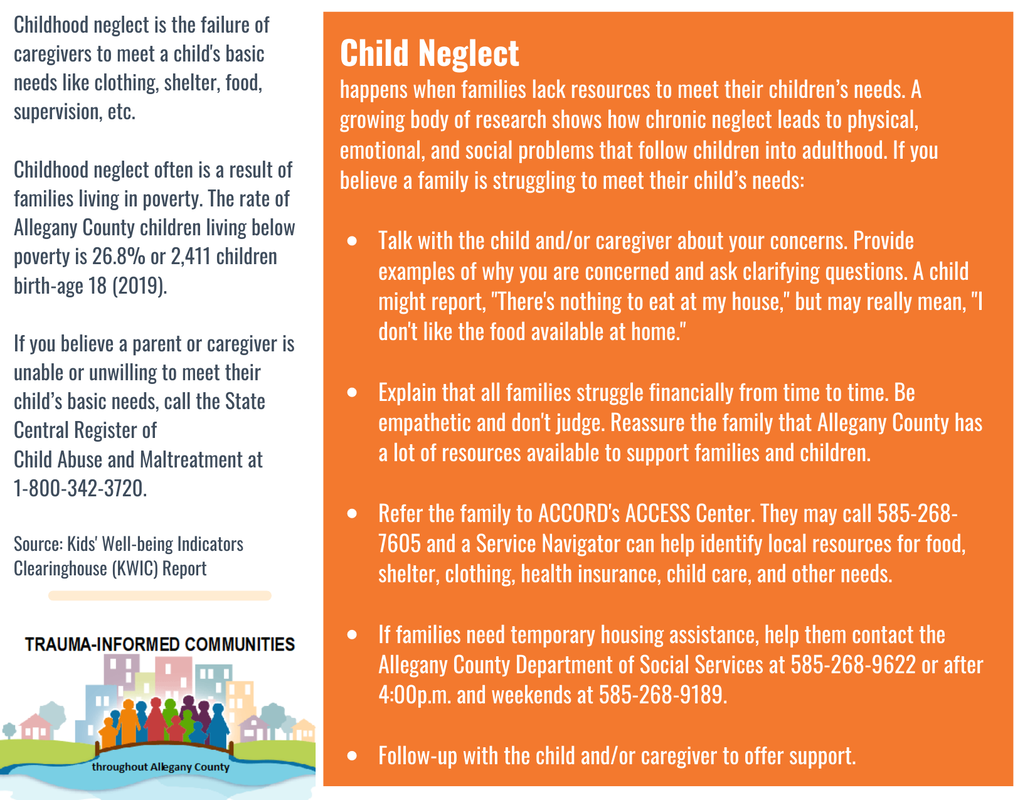- Home
- Trauma-Informed Education
- Trauma Overview
-
#onecaringadult
- #Onecaringadult Allegany County App
- #onecaringadult- Academic Stress
- #onecaringadult- Alcohol and Other Drugs
- #onecaringadult- Bullying
- #onecaringadult- LGBTQ+
- #onecaringadult- Childhood Neglect
- #onecaringadult- E-Cigarettes and Vaping
- #onecaringadult- Eating Disorders
- #onecaringadult- Mental Health
- #onecaringadult- Online Sexual Exploitation
- #onecaringadult- Non-Suicidal Self-Injury
- #onecaringadult- Sexual Abuse
- #onecaringadult- Sexually Transmitted Infections
- #onecaringadult- Suicide Prevention
- #onecaringadult- Teen Dating Violence
- #onecaringadult- Teen Pregnancy
- #onecaringadult- Toxic Stress
- #onecaringadult- Vaping & E-Cigarettes
- #onecaringfriend
- Trauma-Informed Resources
Child neglect is when a parent or caregiver does not give the care, supervision, affection and support needed for a child’s health, safety and well-being. Child neglect includes physical neglect and inadequate supervision, emotional neglect, medical neglect and/or educational neglect.
Angela Tinder, Allegany County DSS
WHAT YOU NEED TO KNOW ABOUT CHILD NEGLECT
|
Types of Child Negelct
Physical Neglect
Children need enough care to be healthy and enough supervision to be safe. Adults that care for children must provide clothing, food and drink. A child also needs safe, healthy shelter, and adequate supervision. Examples of physical neglect include:
Medical Neglect
Some states do not prosecute parents who withhold certain types of medical care for religious reasons, but they may get a court order to protect the child’s life. Parents and caregivers must provide children with appropriate treatment for injuries and illness. They must also provide basic preventive care to make sure their child stays safe and healthy. Examples of medical neglect include:
Emotional neglect
Children require enough affection and attention to feel loved and supported. If a child shows signs of psychological illness, it must be treated. Examples of emotional neglect include:
Educational Neglect
Parents and schools share responsibility for making sure children have access to opportunities for academic success. Examples of educational neglect include:
Source: www.childhelp.org
Recognizing Child Neglect
Child neglect may be seen in children who:
Tips to Help Prevent Child Neglect
Supporting families and increasing protective factors within a community can help prevent child neglect.
Be a Good Neighbor
Prevention can be as easy as friendship. Often, struggling families just need a listening ear. If you notice a neighbor or friend struggling with parenting, ask what you can do to help, and tell them you are there for them. Donate Basic Care Items
Families in need often need small, everyday items to not only care for their family, but also to feel supported by their community. Families may need cleaning supplies, toiletries, diapers, personal hygiene products, laundry assistance, and other items that cannot be obtained with their government benefits. Become a Mentor
Becoming a parent can be challenging and often new moms and dads feel alone and are not sure what to do. By becoming a mentor, you can help guide families by offering your knowledge and experience as a parent. Help Connect Families with Services
Our community is rich with resources. If you are aware of a family in need, help connect them to services like food pantries, clothing closets, and governmental benefit programs. Offer Parenting Workshops
Churches, non-profits, schools, child care providers, and other organizations can offer parenting programs to help build parenting skills and decrease family isolation. |
Learn More About Child Neglect
Helpful Links
|
- Home
- Trauma-Informed Education
- Trauma Overview
-
#onecaringadult
- #Onecaringadult Allegany County App
- #onecaringadult- Academic Stress
- #onecaringadult- Alcohol and Other Drugs
- #onecaringadult- Bullying
- #onecaringadult- LGBTQ+
- #onecaringadult- Childhood Neglect
- #onecaringadult- E-Cigarettes and Vaping
- #onecaringadult- Eating Disorders
- #onecaringadult- Mental Health
- #onecaringadult- Online Sexual Exploitation
- #onecaringadult- Non-Suicidal Self-Injury
- #onecaringadult- Sexual Abuse
- #onecaringadult- Sexually Transmitted Infections
- #onecaringadult- Suicide Prevention
- #onecaringadult- Teen Dating Violence
- #onecaringadult- Teen Pregnancy
- #onecaringadult- Toxic Stress
- #onecaringadult- Vaping & E-Cigarettes
- #onecaringfriend
- Trauma-Informed Resources
